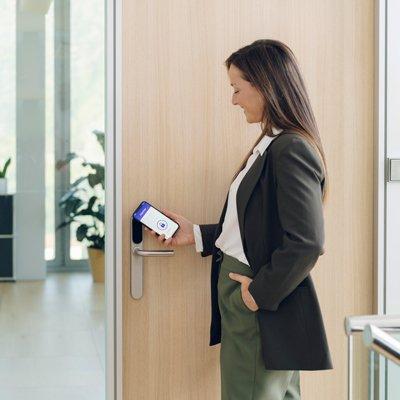 |
| George Mason's magnetic ID card system needed to be replaced with a more efficient smart card solution |
As the commonwealth of Virginia’s largest public university, George Mason University has a population of more than 30,000 students with nearly 5,000 facility members and 2,000 contractors on campus. Showing no signs of slowing its student enrolment, George Mason is a rapidly expanding campus with new facilities and residential halls under construction, and new services being deployed each year.
However, an outdated and vulnerable Mason ID card system needed to be replaced with a more secure and comprehensive “one card” solution that could provide better security, efficient end-to-end issuance capabilities and connect card holders to new services and departments on campus. Most importantly, the university needed a cost-effective migration plan if it were to completely replace its legacy student ID card system.
Vulnerabilities of magnetic swipe technology
For over a decade, George Mason has been issuing Mason ID cards with magnetic swipe technology to its students, faculty and contractors. These legacy cards not only wore out quickly but they relied on a security technology that lacked the cryptographic capabilities of smart cards, and were thus susceptible to cloning and counterfeiting. It was also difficult to update and manage old campus door locks and cards.
Needing to address today’s increasing security challenges, George Mason also recognised that with any new technology deployment on campus, they had an opportunity to lay a foundation that would help the university meet the needs and the expectations of a very technology-savvy generation of students.
Greater campus security could be achieved by moving to a new contactless smart card technology, but the greatest efficiency and convenience would come from leveraging the power of a flexible, “one card” solution that enabled the Mason ID to be used with not only access control systems, but other value-added applications and services on and off campus.
The greatest efficiency and |
Determined to move to a new and comprehensive ID solution, George Mason was conscious of its limited budget and the time and cost associated with replacing existing card infrastructure and ultimately, rebadging its more than 30,000 card holders on campus.
Migrating to a smart ID solution
By working with HID Global and its parent ASSA ABLOY, George Mason was able to design a cost-effective and comprehensive, end-to-end ID solution that would enable university administrators to migrate their existing card system over an expected five years. Simultaneously compatible with the legacy student ID cards and the existing hardware on campus, this new solution would be deployed slowly and consist of the following:
- HID Global multiCLASS SE® readers, as well as PERSONA® Campus Software and SARGENT Passport® locks from HID Global’s parent company, ASSA ABLOY. Chosen for their built-in encryption and enhanced security, the multi-technology readers and locks also support the legacy magnetic stripe (magstripe) cards used on campus as well as newer, contactless card technology.
- Seos® smart cards from HID Global were chosen for their advanced security, interoperability between the new locks and readers, and the multiple card applications enabled by its breakthrough technology. For instance, the university leveraged HID Global OMNIKEY® desktop readers to extend the Seos card’s use to check out library books and to pay for meals in the cafeteria.
- HID Global FARGO® DTC4500e ID card printers and encoders along with its Asure ID® card personalisation software were installed at the campus card office. Cards are personalised by printing student information to the card at the same time encoding and programming of both magstripe and Seos technologies are completed for each multi-tech card in a single, inline issuance process. Total issuance time is drastically reduced, data entry mistakes are eliminated and the new ID cards are printed at higher quality with more durable lamination.
"With the new printers and |
“One of our goals is to get the students out of the card office as quickly as possible. We wanted something that was seamless, so staff could search for the person, verify the identity, print the card and hand it to the person, knowing that it would work right away,” said Jerry Baugh, Director of the Mason Card Office with George Mason University. “With the new printers and Asure ID software, we were able to really streamline the entire card process and set up a true one-stop shop on campus that not only reduced the waiting time for the student, but produced a more durable and better looking card that eliminated the hassle and costs of replacing cards that used to wear out too quickly.”
George Mason worked closely with HID Global and ASSA ABLOY to chart a three-year migration path for its new solution. To date, George Mason has installed about 3,500 new HID Global readers and ASSA ABLOY locks, and has issued more than 12,000 new Mason ID cards to incoming freshmen to start. The university expects to complete its card migration by 2017 with more readers and locks to follow.
Powered by Seos smart card technology, the new Mason ID cards are initially being used for accessing facilities, residence halls, library and cafeteria services. The multi-technology readers and locks ensure the total system also works with the older magstripe ID cards still in use. Potential applications for the new Mason ID include cashless payment for the Washington D.C. transit system, time and attendance when at the gym, and even generating one-time password (OTP) soft tokens to allow students and faculty to access cloud applications, data and other services in the future.
State-of-the-art university access control
The university now has state-of-the-art facility security as well as real-time control when a lock-down or other changes are needed. They also can quickly and easily modify their access control system, including updating card privileges, revoking and replacing lost or stolen cards, and adding or removing applications, while the new ID card also frees the students to easily access so many aspects of campus life.
The move to a Seos-based |
The move to a Seos-based technology solution has provided the university with more freedom of choice and the ability to add more applications as it scales in the future, while providing the confidence that the university is receiving the best-in-class security and privacy protection for its students and staff. In the coming years, George Mason has positioned itself to take full advantage of its ID system to extend not only the many uses for the Mason ID, but the form factor of the student ID itself.
“For us, Seos is a short step; we want bigger, better, newer, faster. We know mobile credentials are coming, and we want to be positioned. We know our readers are already there, so the ability for us to leverage mobile credentials and send those to the phone will be our next step,” stated Danny Anthes, Senior Manager of Information Technology with George Mason University. “I think Seos goes beyond just door access, it speaks better to the credential and pieces we have in that. It allows us to put the destiny of the department back into their own hands.”
Download HID White Paper: Best practices for integrating mobile into the access control architecture now!


















